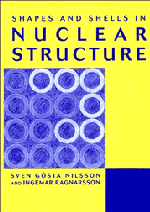Book contents
- Frontmatter
- Contents
- Preface
- 1 Naturally occurring and artificially produced nuclei
- 2 Charge and matter distribution in nuclei
- 3 The semi-empirical mass formula and nuclear stability
- 4 Nuclear fission and the liquid-drop model
- 5 Shell structure and magic numbers
- 6 The nuclear one-particle potential in the spherical case
- 7 The magnetic dipole moment and electric quadrupole moment for nuclei with closed shells ±1 nucleon
- 8 Single-particle orbitals in deformed nuclei
- 9 The shell correction method and the nuclear deformation energy
- 10 The barrier penetration problem – fission and alpha-decay
- 11 Rotational bands – the particle–rotor model
- 12 Fast nuclear rotation – the cranking model
- 13 The nucleon–nucleon two-body interaction
- 14 The pairing interaction
- Solutions to exercises
- References
- Index
4 - Nuclear fission and the liquid-drop model
Published online by Cambridge University Press: 12 January 2010
- Frontmatter
- Contents
- Preface
- 1 Naturally occurring and artificially produced nuclei
- 2 Charge and matter distribution in nuclei
- 3 The semi-empirical mass formula and nuclear stability
- 4 Nuclear fission and the liquid-drop model
- 5 Shell structure and magic numbers
- 6 The nuclear one-particle potential in the spherical case
- 7 The magnetic dipole moment and electric quadrupole moment for nuclei with closed shells ±1 nucleon
- 8 Single-particle orbitals in deformed nuclei
- 9 The shell correction method and the nuclear deformation energy
- 10 The barrier penetration problem – fission and alpha-decay
- 11 Rotational bands – the particle–rotor model
- 12 Fast nuclear rotation – the cranking model
- 13 The nucleon–nucleon two-body interaction
- 14 The pairing interaction
- Solutions to exercises
- References
- Index
Summary
Fission was the third of the modes of nuclear decay to be discovered. Alpha and beta decay had been studied since their discovery in 1895. Nuclear fission was not discovered until 1938, when O. Hahn and F. Strassmann (1938, 1939) bombarded uranium with neutrons and definitely identified barium atoms in the products in the reaction resulting from neutron capture in uranium. This reaction had been studied extensively (see Amaldi, 1984, for a review of these years of physics) since shortly after the discovery of the neutron in 1932. However, as the reaction was expected to yield transuranium elements it was not until the work by Hahn and Strassmann that it was realised that a new and entirely unexpected nuclear phenomenon was being observed.
Hahn's coworker Lise Meitner and her nephew O. Frisch (Meitner and Frisch, 1939) coined the word fission for the new phenomenon discovered by Hahn and Strassmann. The word is a loan from biology. In close cooperation with Niels Bohr the former authors also correctly interpreted the reaction as a break-up of the nucleus into two smaller fragments and offered the first qualitative explanation of the phenomenon in terms of competition between the disrupting trend of Coulomb repulsion and the shape-stabilising effect of surface tension. The effect should have been anticipated from the liquid-drop model. Thus, for heavy nuclei the large number of positively charged protons repel each other so strongly that the small amount of energy added to the nucleus by the impinging neutron (adding its binding energy) is sufficient to make it break apart.
- Type
- Chapter
- Information
- Shapes and Shells in Nuclear Structure , pp. 29 - 45Publisher: Cambridge University PressPrint publication year: 1995



